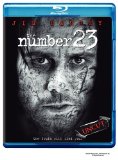| Reviews & Columns |
|
Reviews DVD TV on DVD Blu-ray 4K UHD International DVDs In Theaters Reviews by Studio Video Games Features Collector Series DVDs Easter Egg Database Interviews DVD Talk Radio Feature Articles Columns Anime Talk DVD Savant Horror DVDs The M.O.D. Squad Art House HD Talk Silent DVD
|
DVD Talk Forum |
|
|
| Resources |
|
DVD Price Search Customer Service #'s RCE Info Links |
|
Columns
|
|
|
Number 23: Unrated/Rated, The
New Line // R // October 6, 2009
List Price: $28.99 [Buy now and save at Amazon]
The Film:
"Pink is my favorite color. Do you know what Pink is? Red 27, White 65, 65 plus 27 is 92. Pink has four letters, 92 divided by four -- twenty-****ing-three!!"
Yep, that exact quote can be found in Joel Schumacher's The Number 23, along with a broad mishmash of countless more whacked-out, nonsensical contortions that Jim Carrey's character Walter Sparrow spurts out. There's a concept at play that speaks to our curiosity, churning around the worrisome notion that we manifest fear based on our own mental headspace contorting reality. That, however, maxes out the thoughtfulness behind this sizzle-less schlep of a thriller, a labyrinth of blisteringly overblown visuals and half-baked twists and turns made only marginally watchable by Carrey's paranoia-stricken performance.
Walter Sparrow (Carrey) was born on February 3rd, the first of many, many usages of the number 23 throughout our story. He loves his job as an animal control officer (read: dog catcher) and has a nice little life with his wife Agatha (Virginia Madsen) and son Robin (Logan Lerman). On his birthday, a dog bite causes him to be late and stumble by his wife in a bookshop -- where he sees her flipping through a book entitled "The Number 23" by Topsy Kretts (yes, Top-sy-Kretts), a fearful mystery novel revolving around the number's connectivity. Walter ends up reading the book and, after a little time with it, begins to see the number everywhere. Social security number, birthday, house address, the number 92 divided by 4 -- nothing can escape the terror of the feared number 23. Nothing.
Early on, it's easy to surrender to The Number 23 and its web of mind-rattling chaos, if only for the sake of indulging in a madman's ravings over a natural enigma. As Walter flips through the book, a noir of sorts featuring a rogue-ish detective named Fingerling, his obsession with the ominous number interwoven in the book's narrative mirrors the kind of theoretical craze swirling around Dan Brown's "The Da Vinci Code", only without any historical context. His frantic connecting-of-dots is ludicrous, without question, yet we're able to be forgiving at first simply for the thrill of the hunt. There's also a sense of enjoyment behind Walter placing himself and the people around him in the book he's reading, even if an overtly garish -- albeit competently designed -- visual style cripples the intrigue generated in these sequences.
Any surface-riding curiosity, however, quickly fades during a series of frantic, overblown yelling about the "damn numbers", starting with the spewing from a character named Suicide Blonde (Lynn Collins, Numb) in the novel Walter's reading. Soon after he begins to lose his sanity and starts theorizing about how the book's little clues directly connect to his life, The Number 23 also loses its head and begins a brash, blazing tumble down the rabbit hole. The connections grow overwhelmingly silly and several plot holes quickly rise to the surface as the complexity heightens, leaving us grasping at straws to try and keep our interest while the film brays on about its self-perceived suspenseful depth. Those straws we're reaching for happen to be the performances of Jim Carrey and Virginia Madsen, both whom stay stone-faced adept throughout the dizzying runaround. Especially Carrey, who exhibits an interesting mix between his signature physical comedy and the dourness he presents so well in Michel Gondry's masterful Eternal Sunshine of the Spotless Mind, as well as an oddly sadistic entity as the tatted-up, sax-wielding detective Fingerling.
Instead of boiling to a psychological climax that might possibly justify all The Number 23's numerical knee-jerk absurdity, Schumacher and writer Fernley Phillips bust out a big, elaborate reveal -- which is unsurprising and, to equal measure, a derivative retread. It takes much too long to explain everything in an 11th hour breakneck attempt to be interesting, making it look like a fish's last desperate gasps at life before suffocating. And it all comes from the mysticism and connectivity behind a double-digit number, which transforms into one of the more frustrating villains able to be encountered in any type of thriller flick. As mentioned before, the cerebral possibilities with The Number 23 could've been vast and absorbing in an examination on the internalization of our own self-created fears, but instead Joel Schumacher gives us a villain -- an actual, bloodthirsty villain -- in the magical number that seeps any cerebral interest clean from its limited palette.
It transforms into nothing more than a watered-down, visually succulent Hollywood attempt to emulate the brimming intensity in Darren Aronofsky's Pi, with a little bit of detective story murder-mystery littered in to fill the gaps -- and the outcome of the equation is an absolute rat's nest of figures that simply fail to add up. Or, if we're taught anything by The Number 23, it's that any rattled brain can simply force the numbers to add up to their own design, either consciously or subconsciously. Just think, though, that if the math had been done to add two plus three (2+3) into five (5) instead of multiplying two and three (2*3) into six (6), the "devil's number" when in a string of three, we could've avoided this whole cinematic mess. Maybe.
Anybody have an aspirin?
The Blu-ray:
Video and Audio:
Warner Brothers / New Line have presented The Number 23 in its 2.35:1 theatrical framing, encoded in a favorably strong 1080p VC-1 encode. There are two elements to consider when looking at the image for Joel Schumacher's film, the real-life shots and the lurid book-created scenes. All of the sequences in real-time exhibit some dark, tightly-rendered images, rich with plenty of lush colors, attention to fine detail, and mostly accurate rendering of contrast levels that only teeter to reddish/grayish levels in a handful of scenes. The color palette, heavily saturated with bright hues, packs plenty of high-definition pop through a thin veil of low-distortion film grain. Three-dimensional depth is handled exceptionally well, along with the textures and tones present in close-ups on Jim carrey and Virginia Madsen, et al. On the flip side, we've got several scenes that are manipulated to high hell, which often exhibit overblown contrast and unruly palette fluctuations -- and they look as fine as you might expect. It's a distortion-free, natural, tightly-presented image of a part-brash, part-appealing image.
Accompanying the VC-1 picture, the DTS HD Master Audio track offers a pretty full cinematic experience with impressive sound texture. When the blitzed bickering about the number gets everyone in a tizzy, we've got to have a track that supports the dialogue to audible levels. New Line's audio option does that rather well, though a few of the more raspy scenes and some of Jim Carrey's lower-leveld dialogue grow slightly inaudible. Many instances of surround activity float to the back, both with sound effects and the rapid-fire musical cues, which aid in the claustrophobic ambiance of the picture. Lower-frequency activity is infrequent, but a few splashes of sound tackle the lower and mid-range regions -- mostly in fluttering musical notes that pound downwards. It's a well-separated, distinguished audio presentation that supports the visual appeal as well as possible. Only the English DTS Master Audio track is available for sound options, while optional English SDH subtitles are the only option to accompany the film.
Special Features:
Commentary with Joel Schumacher (Theatrical Only):
Schumacher's track is a lackadaisical one, mostly meandering off-topic and certainly not on-point with many of the scenes. His chatter instead leans on elaborating on his actors and his production design, filled with plenty of side tangents and the like. You've got to really dig to find nuggets in this commentary, though a few will surface -- like some discussion about budget and shooting schedules.
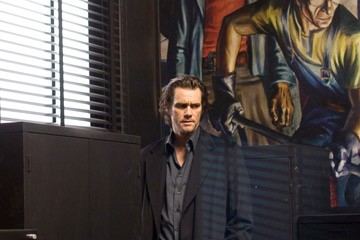 Making of The Number 23 (22:20, HD VC-1):
Making of The Number 23 (22:20, HD VC-1):
Following the traditional structure of the assembly featurette, the filmmakers and cast sit down and offer insights and interview into the build of the film. They discuss the inception of the picture, from lifting up writer Fernley Phillips to get his script made into a film to Jim Carrey and Virginia Madsen's fondness for the script. They also delve into the inherent nature of Fingerling, and how well Carrey pieces together the character.
Creating the World of Fingerling (11:01, HD VC-1):
Here, we've got a featurette that tackles the CG-infused sequences, which addresses Schumacher's drive to milk as much visual panache as possible from the picture. It's interesting that Schumacher mentions the word "genius" in his interviews, since he somewhat lambasts the usage of the word in his commentary -- while skating by by saying that they're geniuses with a "small g". But that's neither here nor there. Carrey and Madsen flip words about the style, showcasing the differences in the worlds and how they parallel to each other. It harks on the sublime production design, one of the film's few saving graces.
The 23 Enigma (25:03, HD VC-1):
Easily the most intriguing special feature of the lot, this lengthy analysis on the numerical coincidences and mathematical structure lying underneath this phenomenon brings in the experts for a crack at the evidence. Three professors analyze the numbers, reminding us of the equations in everyday life and that mathematicians can be musicians. It talks about how Psalm 23 directly affected Jim Carrey's life, how Virginia Madsen received feedback about other numbers from her sharing of the phenom, and how numbers are a "manifestation of the mind" and, in ways, the root of everything.
How to Do Your Numbers:
This feature talks about the many different types of numerological implications behind your name and birthdate, as well as how it interacts with your life. It comes with an Introduction, a way to calculate your "Life Number", as well as summaries of each number in the spectrum and their implications. For those that believe in the deeper meaning behind numerology, it's an interesting exercise.
Also available are two supplemental tracks that play with the film, the Focus Points track that makes an icon available during the film to access details on the conceptualization and construction of the film, and a textual Fact Track of trivia that rides the lower-quadrant of the screen in subtitle form. Each of these are only available on the Theatrical Cut of the film. Furthermore, a series of Deleted Scenes (14:38, VC-1) round everything out, as well as a Theatrical Trailer.
Final Thoughts:
As someone who enjoys a good conspiracy yarn -- especially when it involves numerology and/or symbology -- and has grown to be a large admirer of Jim Carrey's dramatic poise, it was nothing but disappointing to be let down by the erratic nonsense in The Number 23. It's hard to believe that this piece of work came from the same director of Falling Down and Tigerland, though it's not all that hard when you consider the likes of Batman and Robin. Though Carrey does the most that he can with the material, it's mostly one-third of a mediocre thrillride and two-third of an abysmally contrived one, crippled by its own convolution. New Line's Blu-ray actually looks and sounds extremely good, along with offering a few quality supplements that include a commentary and a slate of semi-intriguing featurettes. Yeah, Carrey's performance and the lunacy behind the number itself makes The Number 23 worth a Rental, just have some form of headache relief planned for the after party.
Thomas Spurlin, Staff Reviewer -- DVDTalk Reviews | Personal Blog/Site
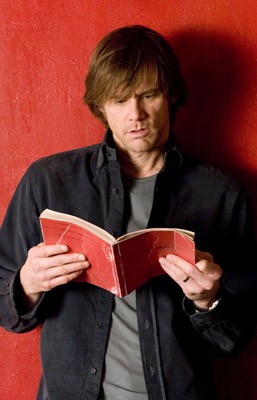 |
Yep, that exact quote can be found in Joel Schumacher's The Number 23, along with a broad mishmash of countless more whacked-out, nonsensical contortions that Jim Carrey's character Walter Sparrow spurts out. There's a concept at play that speaks to our curiosity, churning around the worrisome notion that we manifest fear based on our own mental headspace contorting reality. That, however, maxes out the thoughtfulness behind this sizzle-less schlep of a thriller, a labyrinth of blisteringly overblown visuals and half-baked twists and turns made only marginally watchable by Carrey's paranoia-stricken performance.
Walter Sparrow (Carrey) was born on February 3rd, the first of many, many usages of the number 23 throughout our story. He loves his job as an animal control officer (read: dog catcher) and has a nice little life with his wife Agatha (Virginia Madsen) and son Robin (Logan Lerman). On his birthday, a dog bite causes him to be late and stumble by his wife in a bookshop -- where he sees her flipping through a book entitled "The Number 23" by Topsy Kretts (yes, Top-sy-Kretts), a fearful mystery novel revolving around the number's connectivity. Walter ends up reading the book and, after a little time with it, begins to see the number everywhere. Social security number, birthday, house address, the number 92 divided by 4 -- nothing can escape the terror of the feared number 23. Nothing.
Early on, it's easy to surrender to The Number 23 and its web of mind-rattling chaos, if only for the sake of indulging in a madman's ravings over a natural enigma. As Walter flips through the book, a noir of sorts featuring a rogue-ish detective named Fingerling, his obsession with the ominous number interwoven in the book's narrative mirrors the kind of theoretical craze swirling around Dan Brown's "The Da Vinci Code", only without any historical context. His frantic connecting-of-dots is ludicrous, without question, yet we're able to be forgiving at first simply for the thrill of the hunt. There's also a sense of enjoyment behind Walter placing himself and the people around him in the book he's reading, even if an overtly garish -- albeit competently designed -- visual style cripples the intrigue generated in these sequences.
Any surface-riding curiosity, however, quickly fades during a series of frantic, overblown yelling about the "damn numbers", starting with the spewing from a character named Suicide Blonde (Lynn Collins, Numb) in the novel Walter's reading. Soon after he begins to lose his sanity and starts theorizing about how the book's little clues directly connect to his life, The Number 23 also loses its head and begins a brash, blazing tumble down the rabbit hole. The connections grow overwhelmingly silly and several plot holes quickly rise to the surface as the complexity heightens, leaving us grasping at straws to try and keep our interest while the film brays on about its self-perceived suspenseful depth. Those straws we're reaching for happen to be the performances of Jim Carrey and Virginia Madsen, both whom stay stone-faced adept throughout the dizzying runaround. Especially Carrey, who exhibits an interesting mix between his signature physical comedy and the dourness he presents so well in Michel Gondry's masterful Eternal Sunshine of the Spotless Mind, as well as an oddly sadistic entity as the tatted-up, sax-wielding detective Fingerling.
Instead of boiling to a psychological climax that might possibly justify all The Number 23's numerical knee-jerk absurdity, Schumacher and writer Fernley Phillips bust out a big, elaborate reveal -- which is unsurprising and, to equal measure, a derivative retread. It takes much too long to explain everything in an 11th hour breakneck attempt to be interesting, making it look like a fish's last desperate gasps at life before suffocating. And it all comes from the mysticism and connectivity behind a double-digit number, which transforms into one of the more frustrating villains able to be encountered in any type of thriller flick. As mentioned before, the cerebral possibilities with The Number 23 could've been vast and absorbing in an examination on the internalization of our own self-created fears, but instead Joel Schumacher gives us a villain -- an actual, bloodthirsty villain -- in the magical number that seeps any cerebral interest clean from its limited palette.
It transforms into nothing more than a watered-down, visually succulent Hollywood attempt to emulate the brimming intensity in Darren Aronofsky's Pi, with a little bit of detective story murder-mystery littered in to fill the gaps -- and the outcome of the equation is an absolute rat's nest of figures that simply fail to add up. Or, if we're taught anything by The Number 23, it's that any rattled brain can simply force the numbers to add up to their own design, either consciously or subconsciously. Just think, though, that if the math had been done to add two plus three (2+3) into five (5) instead of multiplying two and three (2*3) into six (6), the "devil's number" when in a string of three, we could've avoided this whole cinematic mess. Maybe.
Anybody have an aspirin?
The Blu-ray:
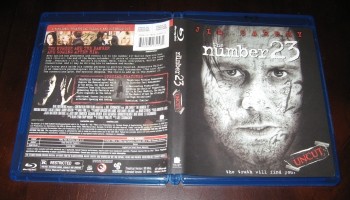 | 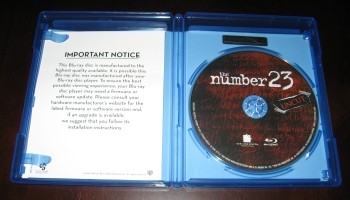 |
| Note: Both versions of The Number 23 are available on this Blu-ray disc -- the 1:38:06 Theatrical Cut and the 1:41:16 Unrated Cut, a cut that makes very little difference aside from showing some extra skin and lingering in spots here and there. |
Video and Audio:
Warner Brothers / New Line have presented The Number 23 in its 2.35:1 theatrical framing, encoded in a favorably strong 1080p VC-1 encode. There are two elements to consider when looking at the image for Joel Schumacher's film, the real-life shots and the lurid book-created scenes. All of the sequences in real-time exhibit some dark, tightly-rendered images, rich with plenty of lush colors, attention to fine detail, and mostly accurate rendering of contrast levels that only teeter to reddish/grayish levels in a handful of scenes. The color palette, heavily saturated with bright hues, packs plenty of high-definition pop through a thin veil of low-distortion film grain. Three-dimensional depth is handled exceptionally well, along with the textures and tones present in close-ups on Jim carrey and Virginia Madsen, et al. On the flip side, we've got several scenes that are manipulated to high hell, which often exhibit overblown contrast and unruly palette fluctuations -- and they look as fine as you might expect. It's a distortion-free, natural, tightly-presented image of a part-brash, part-appealing image.
Accompanying the VC-1 picture, the DTS HD Master Audio track offers a pretty full cinematic experience with impressive sound texture. When the blitzed bickering about the number gets everyone in a tizzy, we've got to have a track that supports the dialogue to audible levels. New Line's audio option does that rather well, though a few of the more raspy scenes and some of Jim Carrey's lower-leveld dialogue grow slightly inaudible. Many instances of surround activity float to the back, both with sound effects and the rapid-fire musical cues, which aid in the claustrophobic ambiance of the picture. Lower-frequency activity is infrequent, but a few splashes of sound tackle the lower and mid-range regions -- mostly in fluttering musical notes that pound downwards. It's a well-separated, distinguished audio presentation that supports the visual appeal as well as possible. Only the English DTS Master Audio track is available for sound options, while optional English SDH subtitles are the only option to accompany the film.
Special Features:
Commentary with Joel Schumacher (Theatrical Only):
Schumacher's track is a lackadaisical one, mostly meandering off-topic and certainly not on-point with many of the scenes. His chatter instead leans on elaborating on his actors and his production design, filled with plenty of side tangents and the like. You've got to really dig to find nuggets in this commentary, though a few will surface -- like some discussion about budget and shooting schedules.
 Making of The Number 23 (22:20, HD VC-1):
Making of The Number 23 (22:20, HD VC-1): Following the traditional structure of the assembly featurette, the filmmakers and cast sit down and offer insights and interview into the build of the film. They discuss the inception of the picture, from lifting up writer Fernley Phillips to get his script made into a film to Jim Carrey and Virginia Madsen's fondness for the script. They also delve into the inherent nature of Fingerling, and how well Carrey pieces together the character.
Creating the World of Fingerling (11:01, HD VC-1):
Here, we've got a featurette that tackles the CG-infused sequences, which addresses Schumacher's drive to milk as much visual panache as possible from the picture. It's interesting that Schumacher mentions the word "genius" in his interviews, since he somewhat lambasts the usage of the word in his commentary -- while skating by by saying that they're geniuses with a "small g". But that's neither here nor there. Carrey and Madsen flip words about the style, showcasing the differences in the worlds and how they parallel to each other. It harks on the sublime production design, one of the film's few saving graces.
The 23 Enigma (25:03, HD VC-1):
Easily the most intriguing special feature of the lot, this lengthy analysis on the numerical coincidences and mathematical structure lying underneath this phenomenon brings in the experts for a crack at the evidence. Three professors analyze the numbers, reminding us of the equations in everyday life and that mathematicians can be musicians. It talks about how Psalm 23 directly affected Jim Carrey's life, how Virginia Madsen received feedback about other numbers from her sharing of the phenom, and how numbers are a "manifestation of the mind" and, in ways, the root of everything.
How to Do Your Numbers:
This feature talks about the many different types of numerological implications behind your name and birthdate, as well as how it interacts with your life. It comes with an Introduction, a way to calculate your "Life Number", as well as summaries of each number in the spectrum and their implications. For those that believe in the deeper meaning behind numerology, it's an interesting exercise.
Also available are two supplemental tracks that play with the film, the Focus Points track that makes an icon available during the film to access details on the conceptualization and construction of the film, and a textual Fact Track of trivia that rides the lower-quadrant of the screen in subtitle form. Each of these are only available on the Theatrical Cut of the film. Furthermore, a series of Deleted Scenes (14:38, VC-1) round everything out, as well as a Theatrical Trailer.
Final Thoughts:
As someone who enjoys a good conspiracy yarn -- especially when it involves numerology and/or symbology -- and has grown to be a large admirer of Jim Carrey's dramatic poise, it was nothing but disappointing to be let down by the erratic nonsense in The Number 23. It's hard to believe that this piece of work came from the same director of Falling Down and Tigerland, though it's not all that hard when you consider the likes of Batman and Robin. Though Carrey does the most that he can with the material, it's mostly one-third of a mediocre thrillride and two-third of an abysmally contrived one, crippled by its own convolution. New Line's Blu-ray actually looks and sounds extremely good, along with offering a few quality supplements that include a commentary and a slate of semi-intriguing featurettes. Yeah, Carrey's performance and the lunacy behind the number itself makes The Number 23 worth a Rental, just have some form of headache relief planned for the after party.
|
| Popular Reviews |
| Sponsored Links |
|
|
| Sponsored Links |
|
|
| Release List | Reviews | Shop | Newsletter | Forum | DVD Giveaways | Blu-Ray | Advertise |
|
Copyright 2024 DVDTalk.com All Rights Reserved. Legal Info, Privacy Policy, Terms of Use,
Manage Preferences,
Your Privacy Choices | |||||||









